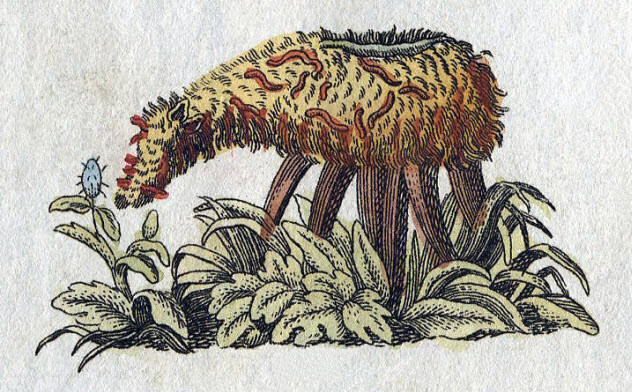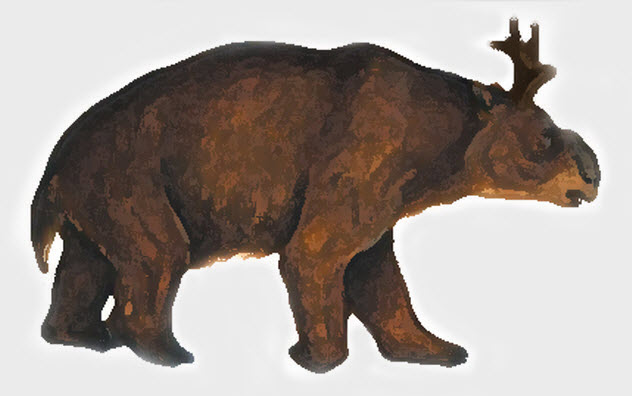 Movies and TV
Movies and TV  Movies and TV
Movies and TV  Creepy
Creepy 10 Lesser-Known Shapeshifter Legends from Around the World
 Animals
Animals 10 Amazing Animal Tales from the Ancient World
 Gaming
Gaming 10 Game Characters Everyone Hated Playing
 Books
Books 10 Famous Writers Who Were Hypocritical
 Humans
Humans 10 of the World’s Toughest Puzzles Solved in Record Time
 Mysteries
Mysteries 10 Scientific Mysteries We Don’t Fully Understand
 Weird Stuff
Weird Stuff 10 Celebrities Who Have Admitted to Alien Encounters
 Our World
Our World 10 Surprising Secrets of Notre Dame Cathedral
 Miscellaneous
Miscellaneous 10 Intriguing Origins of Popular Carnival Rides
 Movies and TV
Movies and TV 10 Actors Dragged out of Retirement for One Key Role
 Creepy
Creepy 10 Lesser-Known Shapeshifter Legends from Around the World
 Animals
Animals 10 Amazing Animal Tales from the Ancient World
Who's Behind Listverse?

Jamie Frater
Head Editor
Jamie founded Listverse due to an insatiable desire to share fascinating, obscure, and bizarre facts. He has been a guest speaker on numerous national radio and television stations and is a five time published author.
More About Us Gaming
Gaming 10 Game Characters Everyone Hated Playing
 Books
Books 10 Famous Writers Who Were Hypocritical
 Humans
Humans 10 of the World’s Toughest Puzzles Solved in Record Time
 Mysteries
Mysteries 10 Scientific Mysteries We Don’t Fully Understand
 Weird Stuff
Weird Stuff 10 Celebrities Who Have Admitted to Alien Encounters
 Our World
Our World 10 Surprising Secrets of Notre Dame Cathedral
 Miscellaneous
Miscellaneous 10 Intriguing Origins of Popular Carnival Rides
10 Bizarre Creatures That People Once Believed To Be Real
Over the centuries, scientists and ordinary people have conjured up many strange, incredible creatures, which were often believed by others to be real. While some were eventually revealed to be hoaxes, others were likely to be actual explanations of living creatures.
10 The Vegetable Lamb Of Tartary

The “vegetable lamb,” a popular myth from the Middle Ages, was believed to be part animal and part plant. Two varieties of the vegetable lamb existed.
One was the fruit of a tree which would burst open when ripe and reveal a perfect imitation of a little lamb within it. The second was an actual living lamb stuck onto a short stem by its navel. The stem was flexible enough for the suspended lamb to bend down and eat the grass around it. When there was no grass left, the stem withered and the lamb died.
It was believed that the vegetable lamb came from a region in Central Europe and Asia which was known as Tartary at the time. Thus, the vegetable lamb is also known as barometz, which means “lamb” in Tartar.
There are many theories as to how the myth of the vegetable lamb was born. One theory suggests that it started with the Greeks who first glimpsed cotton trees on their voyage to India.
However, the myth of the vegetable lamb only became popular in Europe after Sir John Mandeville, the most famous traveler of the Middle Ages, included it in his account of wandering abroad. He stated that the little lambs growing on this peculiar plant were, in his experience, rather delicious.
In 1557, the great Italian polymath Girolamo Cardano tried to debunk this crazy myth by arguing that the soil did not provide enough heat for the lamb to thrive. Still, many people continued to believe that the vegetable lamb existed. Finally, little by little, science debunked the myth completely.
9 Tasmanian Mock Walrus

On April Fool’s Day 1984, the Orlando Sentinel announced the existence of the “Tasmanian mock walrus,” a supposedly tiny creature that feasted on cockroaches and could be kept at home as a pet.
It was said to be about 10 centimeters (4 in) long and had the temperament of a hamster. It was also said to purr like a cat. The story was entitled “Small Wonder” and featured photographs of a naked mole rat posing as the mock walrus. The newspaper also featured photographs of picketers protesting against the government, which had supposedly forbidden the breeding of the mock walrus.
The story was clearly a hoax, and there were many clues in the article for attentive readers to catch. Even the name “mock walrus” suggested that it was purely a prank. But what really gave it away was the last line of the article: “If you ask me, that’s a pretty cruel hoax.”
Nevertheless, plenty of readers failed to catch the joke and genuinely believed in the existence of the Tasmanian mock walrus. For a few days following the publication of the story, the newspaper received plenty of calls and letters asking how to acquire this strange new creature.
Pet stores also received inquiries about the mock walrus. Orlando’s telephone operators received calls from people wanting the phone number of Michael Riverside, the man whose family was supposedly trying to breed this strange animal commercially.
The story of the Tasmanian mock walrus spread all over the world by word of mouth as well as by people sending clips of the original article to their friends and family abroad.
8 The Gunni

In 1967, the gunni (pronounced “goon-eye”) was first reported by timber workers about 16 kilometers (10 mi) from the Australian town of Marysville, although it is believed that the gunni was first sighted by gold miners in the 1860s.
However, the supposed sightings of this bizarre animal are said to be the result of either vivid imagination, liquor, or both. It was believed that the gunni had deerlike antlers and a wombat-like body with striped markings on its back and hindquarters. In reality, the gunni was just a skillful work of taxidermy that fooled many people into believing that the creature was real.
In 2003, Miles Stewart-Howie, a local ranger, installed a stuffed gunni—as well as the history of its antecedents—in Marysville’s visitor center. Shortly afterward, Miles began receiving emails from tourists who insisted that they had spotted the gunni.
One tourist even claimed to have the creature’s droppings in cold storage. Unfortunately, in 2009, the visitors’ center burned down, and the gunni obviously disappeared along with it.
7 Hotheaded Naked Ice Borer

In the April 1995 issue of Discover magazine, senior editor Tim Folger made up a story that explained the disappearance of penguins. These mysterious disappearances were attributed to a strange animal that was capable of melting ice tunnels with its head.
According to the strange but believable story, a scientist named April Pazzo was observing penguins when she noticed that they were squeaking and waddling away quicker than she had ever seen. Pazzo walked past the alarmed birds to determine the cause of the commotion. That’s when she noticed that one penguin was sinking into the ice.
As Pazzo pulled the penguin out, she saw small, hairless, pink, molelike creatures that had attached themselves to the penguin’s lower body. Her curiosity aroused, Pazzo spent the next few months observing these molelike creatures in captivity and in the wild.
Pazzo called these creatures “hotheaded naked ice borers.” They were 15 centimeters (6 in) long, weighed a few ounces, and had a bony plate on their foreheads. It is through these plates that the ice borers supposedly radiated their body heat. In turn, this melted tunnels of ice to hunt penguins.
These ice borers would cluster under a penguin, melt the ice beneath it, and attack the bird when it sank. After they were done with their prey, only the penguin’s webbed feet, its beak, and some feathers remained.
The article ended by suggesting that perhaps the polar explorer Philippe Poisson, who had mysteriously disappeared in Antarctica in 1837, was mistaken for a big penguin and devoured by the hotheaded naked ice borers.
Shortly after the article was published, the magazine received a lot of letters from readers who genuinely believed in the existence of the ice borer.
6 The Pacific Northwest Tree Octopus

Internet users became familiar with the “Pacific Northwest tree octopus” as early as 1998. The tree octopus, which can be found in the temperate rain forests of North America, spends only its early and mating periods of life in an aquatic environment.
Due to its special skin adaptations and the moistness of the rain forest, the Pacific Northwest tree octopus can stay hydrated for long periods of time. Supposedly, it is an intelligent, inquisitive being with advanced behavioral developments.
The tree octopus has eight arms covered in sensitive suckers which the creature uses to grab a branch, pull itself along, strike an insect, or even examine a certain object. Tree octopuses are also capable of displaying their emotions to each another through their changing skin colors: Red shows anger, and white indicates fear.
However, unsuspecting Internet users were most disturbed to learn that this octopus was supposedly endangered due to urban sprawl, predatory house cats, and natural predators such as the bald eagle. A website dedicated to this species urged people to take action to preserve it from extinction.
Of course, there was one little problem: The Pacific Northwest tree octopus has never existed. However, the website dedicated to this hoax has been designed so masterfully that it continues to fool many people, including students taking an Internet literacy test.
5 Goose Barnacle Fruit

In the Middle Ages, local people were baffled by the strange disappearance of a particular type of goose, Branta leucopsis, during its nesting period. After witnessing barnacles floating to shore on pieces of driftwood, these confused observers decided that the geese had no nests.
Instead, the locals believed that barnacles were fruit. They gave birth to these geese after the fruit ripened. Thus, the bird became known as the “barnacle goose,” and the barnacles became known as “goose barnacles.”
According to the legend, when the geese became mature enough, they would fall from the barnacle trees. Any goose that fell into water survived, and any goose that fell onto land died.
Giraldus Cambrensis, a 12th-century bishop, was one of the first to put this legend in writing in his manuscript entitled Topographia Hiberniae. Cambrensis viewed the existence of the barnacle tree as unquestionable evidence of the Immaculate Conception of Christ. Many other religious men also believed this.
Even though Catholic Saint Albertus Magnus denounced the legend of the barnacle tree as false, the fact that most people never witnessed these birds nesting seemed to give credence to the legend. In fact, the legend of the goose barnacles was popular until the 18th century.
4 Lake George Monster
In New York in 1904, the Lake George monster (aka “Georgie”) was born out of an innocent competition between two good friends, Colonel William Mann and Harry Watrous. According to the story, Mann played a fishing trick on Watrous and the latter couldn’t wait to get back at his friend.
Thus, Watrous settled on building a sea monster out of a cedar log that was 3 meters (10 ft) long. Then he painted the log to give it the appearance of a monster and inserted telegraph pole insulators of green glass for eyes.
He also rigged a rope and pulley to make the monster move. Then, while Mann and several of his acquaintances were out on the lake, Watrous gave them the fright of their lives.
But Watrous was having too much fun to stop there. For several weeks after getting back at Mann, Watrous continued to slip the monster into the lake and pull it along the shore, scaring anyone who was nearby.
Shortly afterward, all of New York, as well as the nearby states, had heard of the Lake George monster. Eventually, however, Watrous grew tired of Georgie. It wasn’t until 1920 that the monster was returned to the lake by a man named Louis Spelman.
The reappearance of the monster almost caused serious damage to one boat as all the passengers rushed to one side to get a better look at the monster. Afterward, Spelman hid the monster in his garage.
In 1962, he lent Georgie to Walter Grishkot, who wanted to take a photograph of it. The photograph got a lot of publicity. Eventually, Georgie was sold to a woman in the Virgin Islands for carnival and parade purposes. However, Grishkot got Georgie back a short time later and took it back to Lake George.
3 Hoop Snakes

“Hoop snakes” have supposedly been sighted since colonial times in North America. It is believed that this particular snake grabs its own tail with its mouth and rolls like a hoop after its prey at great speed. The hoop snake is also said to have a venomous stinger in its tail which it uses to finish off its victims.
It is thought that the myth of the hoop snake originated from the behavior of the real-life mud snake, which can be found along the coastal plain of America. The mud snake is passive and does not bite. But it often presses the tip of its tail against its captor’s skin, which has led to the false assumption that it stings.
Many qualities have been attributed to the hoop snake: It is inflated, it glows at night, and it squirts poison from its tail. Nevertheless, although people have claimed to have seen this peculiar creature, no real evidence of the hoop snake exists.
2 Eye-Plucking Prehistoric Owl

In March 2015, Daily Buzz Live, a satirical site that poses as a real news outlet, published an article claiming that Brazilian scientists had found the remains of a giant prehistoric owl called Ornimegalonyx in 2007.
The scientists were able to extract the animal’s DNA and clone the prehistoric owl in 2014. The website went on to say that the owl had attacked scientist Brian Christopher, gouging out his eyes with its talons and beak.
It was said that Christopher lost both of his eyes with no chances of recovering his eyesight. Supposedly, the other scientists then stated that they would take further precautions when dealing with the bird, such as wearing face masks and protective bodysuits.
The disclaimer on Daily Buzz Live warns that the purpose of the website is to entertain and not to inform, so it is not surprising that the article was a fake. While a giant owl named Ornimegalonyx did exist and the photographs used in the article were of an actual bird, the rest of the article was pure imagination.
Still, this did not stop the article from going viral and convincing hundreds of science and nature lovers of the veracity of the story.
1 Woofen-Poof

In 1928, Professor L.W. Sharpe and his assistant, C.B. Fraser, created the hoax of the “woofen-poof,” a curious bird that fooled scientists all over America. The joke was initially targeted at their mutual friend, Dr. L.F. Randolph, a professor of botany.
The woofen-poof was modeled in clay and then cast in iron and aluminum. A monograph that accompanied the creature was supposed to confirm its existence.
The monograph explained that information about the woofen-poof had been gathered during a four-year expedition to the Gobi Desert, the only known location of this strange bird. The woofen-poof supposedly measured 17 centimeters (7 in) in length and had a long beak with a pendulous pouch.
The information on the woofen-poof was first presented in a lecture before the Department of Botany. The speaker, advertised as Professor Augustus C. Fotheringham of the University of New Zealand, was actually Fraser disguised with a white beard.
The audience was mesmerized by the woofen-poof. In fact, the lecture, which was illustrated with faked slides, was such a success that the authors had 500 copies of the speech printed and had their work cited by prestigious science journals numerous times.
Laura is a student from Ireland in love with books, writing, coffee, and cats.








